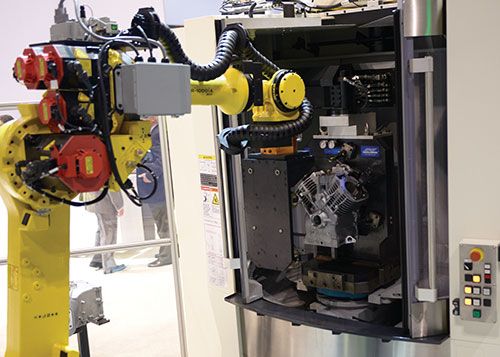Automation Options Reflect Expanded Interest in Unattended, Consistent Production
Post Date: 11 Sep 2014 Viewed: 378

Makino is demonstrating what the company says is the broadest range of automation possibilities it has brought to any IMTS so far. Six distinctly different types of automation for unattended loading and unloading of machines can be seen fully integrated and operational in the company’s Booth S-8700. Mark Rentschler, Makino head of marketing for the Americas, says automation is becoming increasingly important for a growing segment of the company’s customers. There are at least three reasons for this.
First is the skills gap. Among high-value manufacturers across all industries, there is a widespread difficulty in finding qualified, skilled personnel. This is perhaps the most obvious reason automation is in demand, but it is not the sole or even the most significant reason why manufacturers are seeking more automated processes, Rentschler says.
A second factor is the ongoing move, also throughout various industries, toward higher-mix and shorter-leadtime production. The right automation system is an aid to rapidly shifting between part numbers.
A third factor is the increasing sophistication of North American manufacturers. Variables in a manufacturing process are sources of expense. Machine tool automation saves cost by eliminating variation in setup time (which otherwise would depend on the fluctuating pace of a human operator) and variation in machine utilization (which otherwise would be subject to the operator’s breaks and interruptions). The connection between variation and cost is something the largest manufacturers have long understood, but now a significant portion of smaller manufacturers appreciate this as well.
The six different automation solutions seen in the booth include three well-known options (numbers 1-3 below) and three others that will seem surprising or unusual to many shops (numbers 4-6). They are:
1. A pallet system for supplying various part numbers to an individual vertical machining center.
2. The Makino Machining Complex (MMC) pallet system for sharing and exchanging pallets among multiple HMCs.
3. A FANUC robot for machining center loading and unloading. Makino’s control interface includes features aimed at simplifying operation of an integrated robot, as well as recovery if the robot cycle is interrupted.
4. A die-mold cell devised in conjunction with Erowa. The cell includes machines for graphite milling, hard steel milling, wire EDM and sinker EDM, all fed by an Erowa robot. Because many assume that automation requires volume production, the point of this cell is to illustrate automated production of a type of work in which every workpiece is unique: die-mold machining. In this cell, steel blocks enter, and finished mold cores or cavities leave. Integrating multiple manufacturing disciplines into a carefully designed system provides both cost reductions and throughput improvements that stand-alone machines can’t provide, Makino says.
5. Five-axis automation. Because automated loading and unloading require automatic workholding able to repeatably clamp and position the work, five-axis machining is considered challenging to automate. The company’s a51nx-5XU machine is automated using a workholding device that is essentially an inverted 50-taper toolholder receiver. Workpieces mounted on this taper are loaded into the machine by a device resembling a toolholder. The result is secure and repeatable clamping of the part without obstructing the five-axis machining center’s access all around the part.
6. Aerospace automation. The company’s a61nx-5E HMC is automated with a multilayer pallet pool, applied here in a context where it might not be expected. High-power, high-speed machines cutting aluminum aerospace workpieces achieve short cycle times that require workpieces to be delivered to the machine quickly. Modern pallet-pool automation provides the speed to achieve this.
The company’s booth also includes an area dedicated to aerospace engine machining. Various machines focused on this work are featured here, including a five-axis HMC capable of precision grinding, a VMC also equipped for aerospace grinding, and machines engineered for productive machining of coolant holes and root holes.



